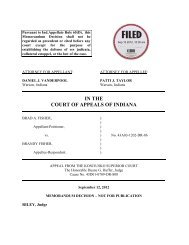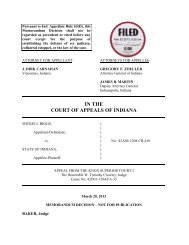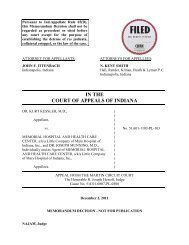Indiana State Health Improvement Plan (I-SHIP) - State of Indiana
Indiana State Health Improvement Plan (I-SHIP) - State of Indiana
Indiana State Health Improvement Plan (I-SHIP) - State of Indiana
Create successful ePaper yourself
Turn your PDF publications into a flip-book with our unique Google optimized e-Paper software.
INDIANA STATE HEALTH IMPROVEMENT PLAN<br />
Partnering for the Public’s <strong>Health</strong><br />
located, has had a consistently high unemployment rate <strong>of</strong> approximately<br />
17-18%. Of <strong>Indiana</strong> residents, 25 years <strong>of</strong> age or older, only 78.8% have<br />
a high school diploma. The percent <strong>of</strong> adults, 25 years <strong>of</strong> age or older,<br />
with BS, BA or graduate degrees is 17.6%.<br />
Infant mortality rates in <strong>Indiana</strong> are some <strong>of</strong> the highest in the nation. In<br />
2006, Black infant mortality rates in Allen and St. Joseph counties were<br />
over 30 per 1,000 live births, the equivalent <strong>of</strong> rates in countries such as<br />
Honduras, Indonesia, and Nicaragua. In addition, <strong>Indiana</strong> has one <strong>of</strong> the<br />
highest smoking rates during pregnancy <strong>of</strong> all states. Likewise, almost<br />
11% <strong>of</strong> births in <strong>Indiana</strong> are preterm and nearly 9% <strong>of</strong> infants born in<br />
<strong>Indiana</strong> are <strong>of</strong> low birth weight.<br />
<strong>Indiana</strong> is challenged by a number <strong>of</strong> health behavior factors impacting<br />
outcomes in the state. For example, childhood and adult obesity rates in<br />
<strong>Indiana</strong> are <strong>of</strong> epidemic proportions (14.6% for children 10-17 years and<br />
30% for adults). Over 26% <strong>of</strong> residents self-report a history <strong>of</strong> high<br />
blood pressure, and over 38% have ever been told they have elevated<br />
cholesterol, both higher than the national average. Leading causes <strong>of</strong><br />
death in <strong>Indiana</strong> for men and women continue to be heart disease, cancer,<br />
chronic lower respiratory infections and stroke, which can all be<br />
attributed to obesity. These issues are further addressed and explored in<br />
this plan.<br />
Counties in numerous regions <strong>of</strong> the state have spent the past three years<br />
recovering from devastating floods in 2008. Flooding displaced<br />
significant numbers <strong>of</strong> <strong>Indiana</strong> residents from their homes temporarily or<br />
permanently. In one regional hospital, the flooding led to the temporary<br />
closure <strong>of</strong> the Emergency Department, pharmacy, and laboratory as<br />
those areas were inundated. Events such as these have highlighted the<br />
need and the impact <strong>of</strong> effective preparedness training and response in<br />
<strong>Indiana</strong> for natural disasters. <strong>Indiana</strong> is also located near the Wabash<br />
Valley Fault, where the risk <strong>of</strong> earthquake in the next 20 years is a<br />
significant threat.<br />
In 2007, the Environmental Integrity Project named 12 <strong>Indiana</strong> coalburning<br />
power plants, including one on the Southside <strong>of</strong> <strong>Indiana</strong>polis,<br />
among the 50 "dirtiest" in the country for producing health-damaging<br />
pollutants. The report underscores the potential health threat from power<br />
company smokestacks throughout <strong>Indiana</strong>.

















